Chapter: Distributed Systems : Introduction
Distributed systems
Distributed systems
Introduction
A distributed system is a software
system in which components located on networked computers communicate and
coordinate their actions by passing messages. The components interact with each
other in order to achieve a common goal.
Distributed
systems Principles
A
distributed system consists of a collection of autonomous computers, connected
through a network and distribution middleware, which enables computers to
coordinate their activities and to share the resources of the system, so that
users perceive the system as a single, integrated computing facility.
Centralised System Characteristics
·
One component with non-autonomous parts
·
Component shared by users all the time
·
All resources accessible
·
Software runs in a single process
·
Single Point of control
·
Single Point of failure
Distributed System Characteristics
·
Multiple autonomous components
·
Components are not shared by all users
·
Resources may not be accessible
·
Software runs in concurrent processes on different
processors
·
Multiple Points of control
·
Multiple Points of failure
Examples
of distributed systems and applications of distributed computing include the
following:
·
telecommunication networks:
o
telephone networks and cellular
networks,
o
computer networks such as the Internet,
o
wireless sensor networks,
o
routing algorithms;
·
network applications:
o
World wide web and peer-to-peer
networks,
o
massively multiplayer online games and
virtual reality communities,
o
distributed databases and distributed
database management systems,
o
network file systems,
o
distributed information processing
systems such as banking systems and airline reservation systems;
o
real-time process control:
o
aircraft control systems,
o
industrial control systems;
•
parallel computation:
§ scientific
computing, including cluster computing and grid computing and various volunteer
computing projects (see the list of distributed computing projects),
§ distributed
rendering in computer graphics.
Common Characteristics
Certain
common characteristics can be used to assess distributed systems
o
Resource Sharing
o
Openness
o
Concurrency
o
Scalability
o
Fault Tolerance
o
Transparency
Resource Sharing
o
Ability to use any hardware, software or data
anywhere in the system.
o
Resource manager controls access, provides naming
scheme and controls concurrency.
o
Resource sharing model (e.g. client/server or
object-based) describing how
o
resources are provided,
o
they are used and
o
provider and user interact with each other.
Openness
o
Openness is concerned with extensions and
improvements of distributed systems.
o
Detailed interfaces of components need to be
published.
o
New components have to be integrated with existing
components.
o
Differences in data representation of interface
types on different processors (of different vendors) have to be resolved.
Concurrency
Components
in distributed systems are executed in concurrent processes.
Components
access and update shared resources (e.g. variables, databases, device drivers).
Integrity of the system may be violated if concurrent updates are not
coordinated. o
Lost
updates
Scalability
o
Adaption of distributed systems to
o
accomodate more users
o
respond faster (this is the hard one)
o
Usually done by adding more and/or faster processors.
o
Components should not need to be changed when scale
of a system increases.
o
Design components to be scalable
Fault Tolerance
Hardware,
software and networks fail!
o
Distributed systems must maintain availability even
at low levels of hardware/software/network reliability.
o
Fault tolerance is achieved by
o
recovery
o
redundancy
Transparency
o
Distributed systems should be perceived by users
and application programmers as a whole rather than as a collection of
cooperating components.
o
Transparency has different dimensions that were
identified by ANSA.
o
These represent various properties that distributed
systems should have.
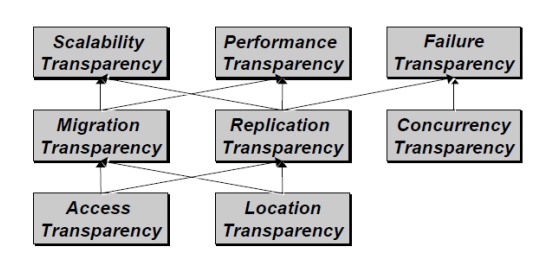
Access Transparency
Enables
local and remote information objects to be accessed using identical operations.
o
Example: File system operations in NFS.
o
Example: Navigation in the Web.
o
Example: SQL Queries
Location Transparency
Enables
information objects to be accessed without knowledge of their location.
o
Example: File system operations in NFS
o
Example: Pages in the Web
o
Example: Tables in distributed databases
Concurrency Transparency
Enables
several processes to operate concurrently using shared information objects
without interference between them.
o
Example: NFS
o
Example: Automatic teller machine network
o
Example: Database management system
Replication Transparency
Enables
multiple instances of information objects to be used to increase reliability
and performance without knowledge of the replicas by users or application
programs
o
Example: Distributed DBMS
o
Example: Mirroring Web Pages.
Failure Transparency
o
Enables the concealment of faults
o
Allows users and applications to complete their
tasks despite the failure of other components.
o
Example: Database Management System
Migration Transparency
Allows
the movement of information objects within a system without affecting the
operations of users or application programs
o
Example: NFS
o
Example: Web Pages
Performance Transparency
Allows
the system to be reconfigured to improve performance as loads vary.
Example:
Distributed make.
Scaling Transparency
Allows
the system and applications to expand in scale without change to the system
structure or the application algortithms.
o
Example: World-Wide-Web
o
Example: Distributed Database
Distributed Systems: Hardware Concepts
Multiprocessors
Multicomputers
Networks
of Computers
Multiprocessors
and Multicomputers
Distinguishing
features:
Private
versus shared memory
Bus
versus switched interconnection

High degree of node heterogeneity:
High-performance
parallel systems (multiprocessors as well as multicomputers)
High-end
PCs and workstations (servers)
Simple
network computers (offer users only network access)
Mobile
computers (palmtops, laptops)
Multimedia
workstations
High degree of network heterogeneity:
Local-area
gigabit networks
Wireless
connections
Long-haul,
high-latency connections
Wide-area
switched megabit connections
Distributed Systems: Software Concepts
Distributed operating system
_ Network operating system
_ Middleware
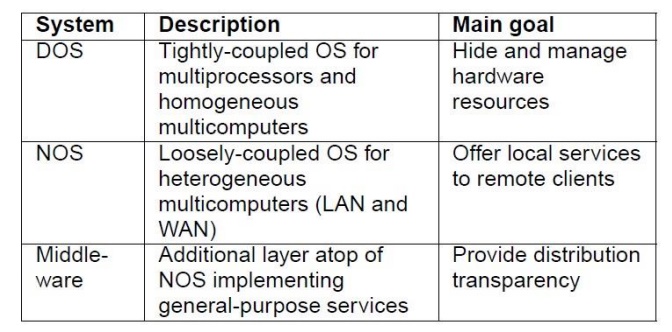
Distributed Operating System
Some characteristics:
_ OS on each computer knows about the other computers
_ OS on different computers
generally the same
_
Services are generally (transparently) distributed across computers

Network Operating System
Some characteristics:
_ Each
computer has its own operating system with networking facilities
_ Computers work independently (i.e., they may even have different operating systems)
_ Services are tied to individual nodes (ftp, telnet, WWW)
_ Highly
file oriented (basically, processors share only
files)
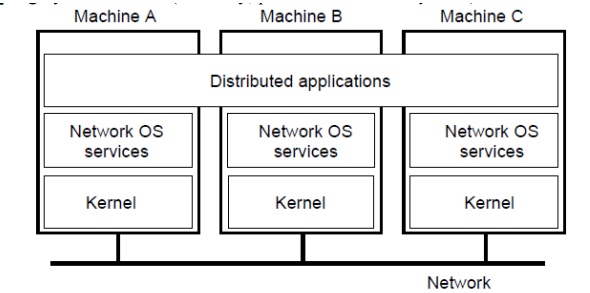
Distributed System (Middleware)
Some characteristics:
_ OS on each computer need not know about the other computers
_ OS on different
computers need not generally be the same
_ Services are generally (transparently) distributed across computers
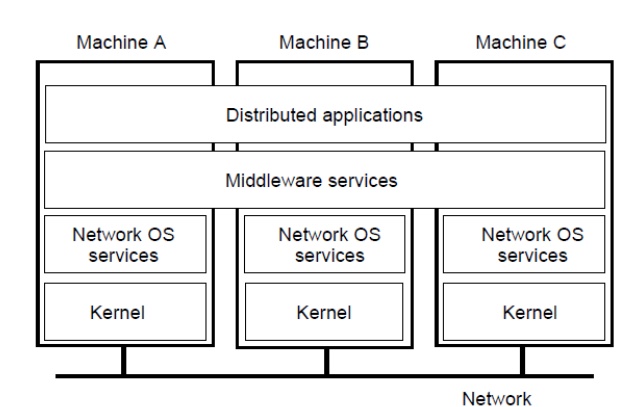
Need for Middleware
Motivation: Too many networked applications
were hard or difficult to integrate:
_
Departments are running different NOSs
_ Integration and interoperability only at level of primitive NOS services
_ Need
for federated information systems:
Setting up enterprise-wide Internet services, making use of existing information systems
Allow transactions across different databases
_ Constraint: use the existing operating systems, and treat them as the underlying environment (they provided the basic functionality anyway)
Communication services: Abandon
primitive socket based message passing in favor of: _ Procedure calls across networks
_ Remote-object method invocation
_ Message-queuing systems
_
Advanced communication streams
_ Event notification service
Information system services: Services that help manage data in a distributed system:
_ Large-scale, system wide naming services
_ Location services for tracking mobile objects
_ Persistent storage facilities
_ Data
caching and replication
Control services: Services
giving applications control over when, where, and how they access data:
_ Distributed transaction processing
_ Code migration
Security services: Services for secure processing and communication:
_ Authentication and authorization services
_ Simple encryption services
_ Auditing service
Comparison of DOS, NOS, and Middleware
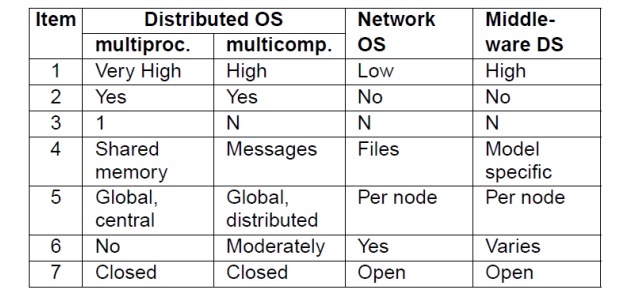
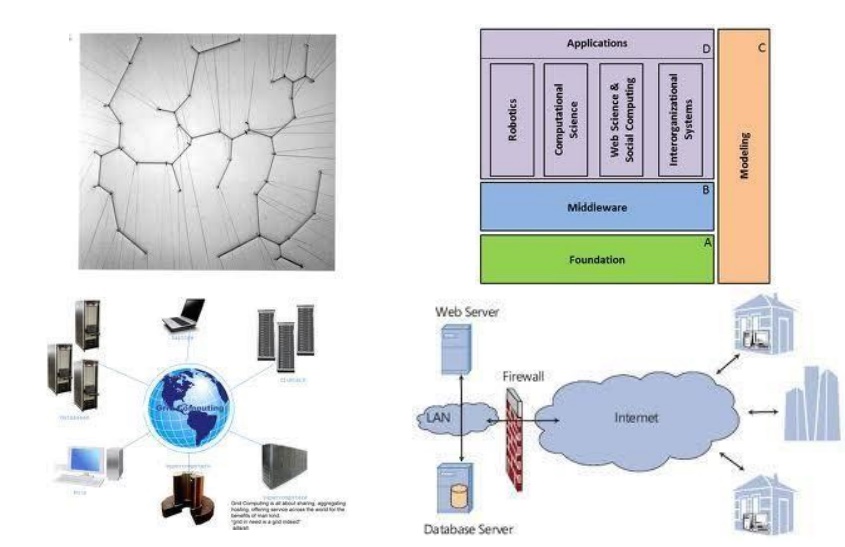
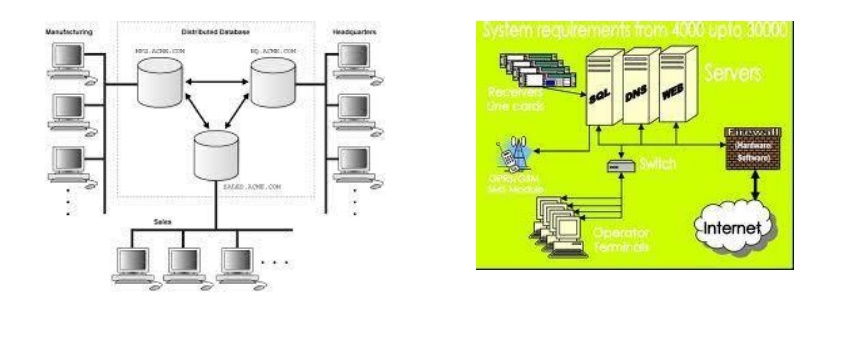

Networks
of computers are everywhere. The Internet is one, as are the many networks of
which it is composed. Mobile phone networks, corporate networks, factory
networks, campus networks, home networks, in-car networks – all of these, both
separately and in combination, share the essential characteristics that make
them relevant subjects for study under the heading distributed systems.
Distributed
systems has the following significant consequences:
Concurrency: In a network of computers,
concurrent program execution is the norm. I can do my work on my computer while you do your work on yours, sharing
resources such as web pages or files when necessary. The capacity of the system
to handle shared resources can be increased by adding more resources (for example.
computers) to the network. We will describe ways in which this extra capacity
can be usefully deployed at many points in this book. The coordination of
concurrently executing programs that share resources is also an important and
recurring topic.
No global clock: When programs need to cooperate
they coordinate their actions by exchanging
messages. Close coordination often depends on a shared idea of the time at
which the programs’ actions occur. But it turns out that there are limits to
the accuracy with which the computers in a network can synchronize their clocks
– there is no single global notion of the correct time. This is a direct
consequence of the fact that the only
communication is by sending messages through a network.
Independent failures: All
computer systems can fail, and it is the responsibility of system designers to plan for the consequences
of possible failures. Distributed systems can fail in new ways. Faults in the
network result in the isolation of the computers that are connected to it, but
that doesn’t mean that they stop running. In fact, the programs
on them
may not be able to detect whether the network has failed or has become
unusually slow. Similarly, the failure of a computer, or the unexpected
termination of a program somewhere in the system (a crash), is not immediately made known to the other components with
which it communicates. Each component of the system can fail independently,
leaving the others still running.
Related Topics